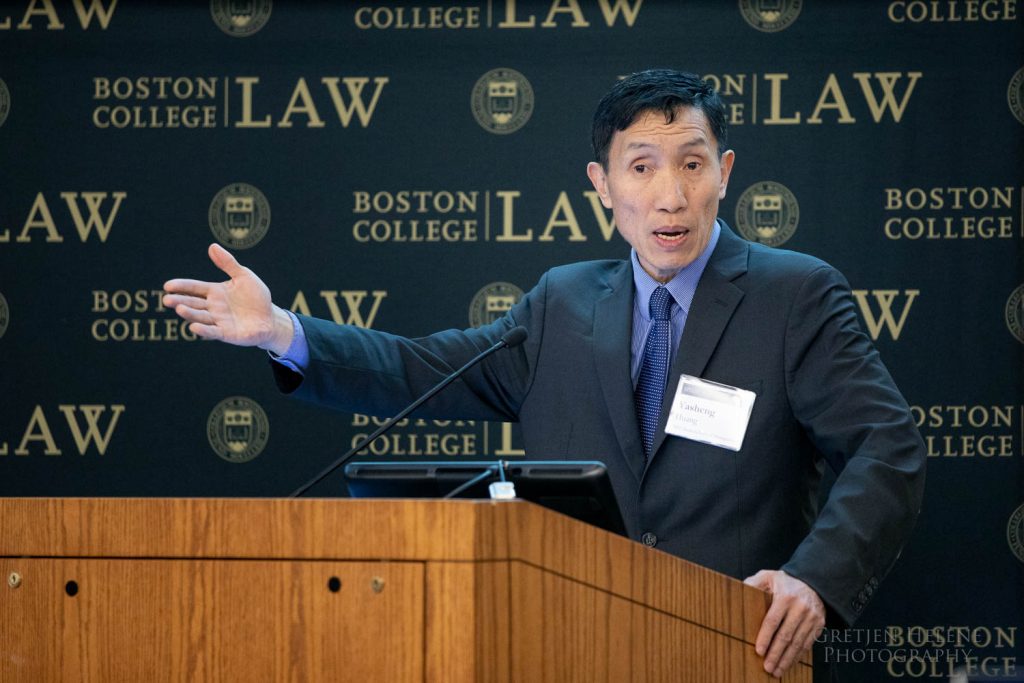When it comes to doing business and protecting intellectual property in China, is confrontation or collaboration the better approach? Legal, business, and government experts gathered at Boston College Law School Oct. 17 and 18 to discuss this and other issues at the Second Annual International IP Summit, sponsored by the Boston College Law School Program on Innovation and Entrepreneurship (PIE), Ropes & Gray, and the Boston Patent Law Association. This year the International IP Summit focused particularly on China.
In the opening address, Yasheng Huang, above, Epoch Foundation Professor of International Management at the MIT Sloan School of Management, urged that the US should be cautious about engaging in a trade war with China. Professor Huang emphasized that evaluating intellectual property rights in laws and enforcement in China requires an understanding of Chinese history and culture. Historically, “the very idea of rights did not exist in the Chinese political culture,” Huang explained. “So how do you establish a subset of rights, such as property rights and IP?”
Huang argued that cooperation, not conflict, is the key to the future of a global marketplace. In terms of working with China, that means looking past the current trade war to understand the rapidly evolving regulatory, intellectual property, and privacy landscape in its burgeoning economy. Huang argued that a trade war harms both the US and China, saying that it “will have substantial long-term damaging impact on both countries.” Instead of focusing on a trade war, he stressed, the US needs to think in terms of a long-term, not short-term, strategy and to separate out and negotiate the various issues.
“The US needs a smarter way of dealing with the challenge of China,” he said. Already, our high tech is very exposed to China, in part because of the size of the China market, and in part because of the high level of governmental support Chinese companies receive. This sometimes can benefit US companies working in China, Huang argued. “To the extent a project is collaborative, part of it is funded by the Chinese government,” he said. “So the R&D investments between the two countries are actually complementary.”
In addition, China’s robust small-scale manufacturing “speeds up the pace by which innovation in universities, innovations in big companies go to market,” according to Huang.
Ultimately, he suggested, the current trade war will hurt China more than the US. However, it will also damage the US, and will have negative global impact. Better, he stressed, to focus on collaboration. “US progress benefits the whole world,” he concluded, “including China.”
Not everyone agreed. The following panel on US/China IP and Trade Policy Trends featured a sometimes spirited debate about confrontation versus collaboration in dealing with IP issues in China. Professor Justin Hughes of Loyola Marymount School of Law argued that because China doesn’t always have a countervailing interest when it comes to negotiating IP rights, the blunt force approach of tariffs may be the best way to get results. Michael Mangelson of the US Patent and Trademark Office described how his office helps US IP owners in China seeking to protect their rights. Mangelson discussed another method for encouraging enforcement of IP rights in China. He noted that after years of negotiation, the US finally filed for sanctions with the WTO, after which China quickly made adjustments to provide more protections for trade secrets held by foreign companies in China.
In a lunchtime discussion, Scott Samuels, senior vice president and general counsel at BeiGene Ltd., discussed the nuts and bolts of working in, and with, China with Charlotte Jacobsen, a biotechnology and pharmaceuticals litigator at Ropes & Gray. In addition to the size of the market and the availability of Chinese government funding, Samuels talked about the clinical opportunities for pharmaceutical companies like BeiGene.
“It’s not as competitive to enroll patients in trials in China,” he explained. Although there have been issues with quality—which explains why many Chinese have historically preferred Western brands—he noted that China has joined the International Council for Harmonisation of Technical Requirements for Pharmaceuticals for Human Use. Between this improved access and the acceptance of international standards, he recognizes “a real opportunity for US and European companies to utilize China for drug development.”
Still, he conceded, there are challenges. “China has a history of generic medicine and is just breaking into innovative drugs,” he said. In addition, as other speakers pointed out, both China’s approach to pharmaceutical patents and to reimbursements under its national healthcare can be frustrating for outsiders.
Panels throughout the day discussed brand rights and acquisitions, including the sticky problems of copyright and trademark enforcement; trade policy reforms and trends; developments in cross-border IP protection, and the regulatory landscape for life sciences in China, among other topics.
Speaking about global cybersecurity and privacy, panelists examined how, since the EU General Data Protection Regulation (GDPR) went into effect in Europe in 2018, China has been developing its own privacy and cybersecurity network. With so much in flux, Katherine Fick, senior counsel, IBM security, IBM corporation, advised “looking at GDPR as a baseline, and then looking at what else will be required on a case-by-case basis.” As her co-panelist Amy Harman Burkart, chief of the cybercrime unit in the US Attorney’s Office, added, “There’s always a weak link.”
On Day 2 of the Summit, a smaller group of experts gathered for a roundtable discussion of Doing Business in China. Businesspersons and lawyers spent the morning engaged in detailed conversations about the experiences and challenges they have had in China. Over time, the group was able to tease out and agree on a number of best practices for doing business in China in 2019 and beyond.
Read more in Ropes & Gray’s report of the event.


